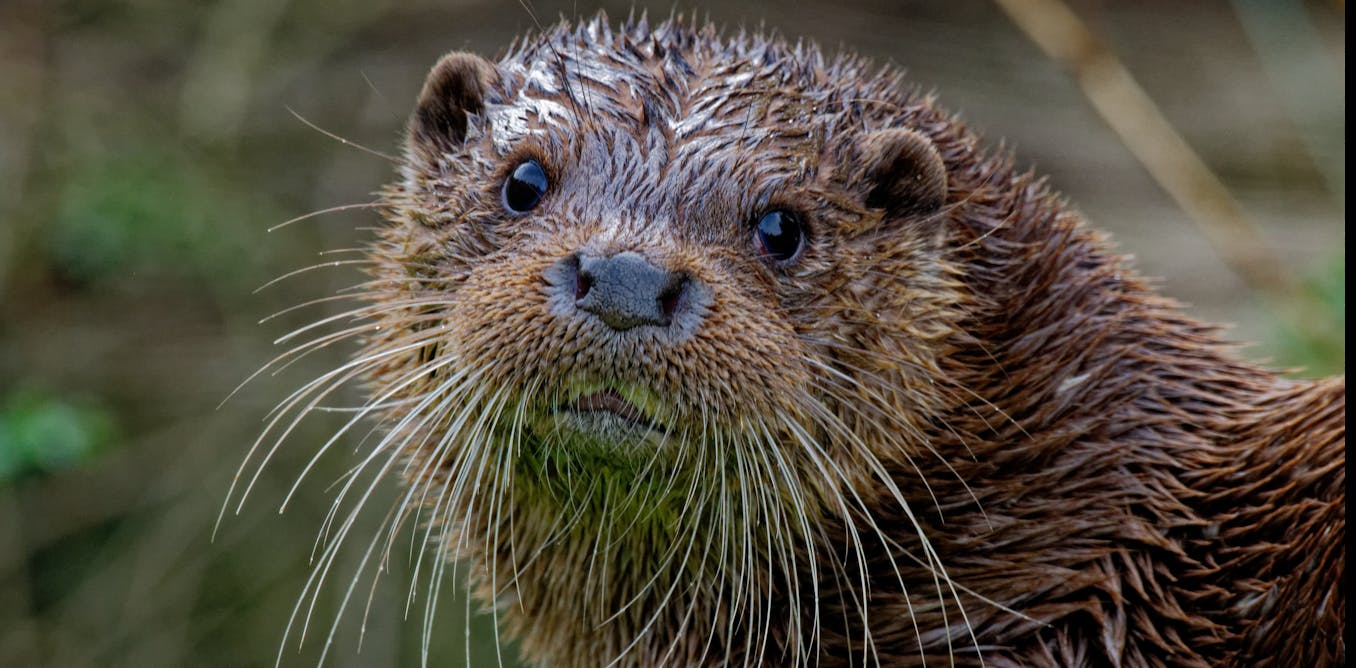Otter populations crashed in Britain around the 1960s from the lethal effects of chemical pollution in rivers and lakes – or so we thought. Our research has looked more closely at what happened to otters in Britain over the last 800 years and has revealed a more complex picture.
Since Eurasian otters (Lutra lutra) are at the top of the aquatic food chain in Britain, any contamination consumed by their prey, and by the prey of their prey, accumulates in otters. So otters are particularly susceptible to any toxic chemicals in their environment.
Following the banning of many chemical pollutants, otter populations began to recover, and we now have otters in every county in Britain. National otter surveys have been conducted in Wales, Scotland and England since 1977 and have helped to track population recovery.
However, we didn’t have a good grasp on what population sizes were like in the decades before this time. We only had anecdotal evidence that otter hunting was becoming less “successful” over time, and that both sightings and signs of otters were rarer.
Otter population decline
Our research shows that roughly between 1950 and 1970, an extreme population decline happened in the east of England, and a strong decline in south-west England. They were probably caused by chemical pollution.
In Scotland, otter populations showed a long-term, but smaller decline, which suggests less chemical pollution. There was a smaller population decline in Wales, which started around 1800, possibly linked to otter hunting and changes in how people shaped and used the landscape.
Ondrej Chvatal/Shutterstock
While both deal with DNA, genetics focuses on individual genes and their roles, while genomics examines the entire set of an organism’s DNA. Although there have been genetic studies of otters in Britain, our research was the first time genomics was used to study Eurasian otters anywhere in the world.
Working with scientists from the Smithsonian Conservation Biology Institute and the Wellcome Sanger’s Darwin Tree of Life project, we looked at the entire otter genome. The upgrade from genetics to genomics threw up a few surprises.
First, there was a mitochondrial DNA sequence found in the east of England, which was very different to the sequences in the rest of Britain. Mitochondrial DNA is a sequence of DNA found in a cell’s mitochondria, which is what generates the energy. Mitochondrial DNA is inherited only from the mother, while the rest of the DNA is a mix of both the mother’s and the father’s DNA.
Another recent study by our research group, in collaboration with colleagues in South Korea, suggested a divergence between these two lineages at least 80,000 years ago. Finding this mitochondrial lineage (that, based on our data, is otherwise restricted to Asia) in the UK was surprising.
Second, we found high levels of genetic diversity in the east of England. Normally, after an extreme population decline such as the one we identified in this area, genetic diversity decreases. Yet we saw much greater diversity here than in the population in Scotland, where there was no clear evidence for such a decline.
Thai otters
With a little detective work, we discovered that a pair of Eurasian otters (the same species that we have in the UK), were brought to Britain from Thailand in the 1960s. Populations of Eurasian otters range right across Europe and Asia. Although they are the same species, there are several genetically distinct subspecies, particularly in Asia.
It seems possible that these genetically different otters from Thailand bred with otters in the east of England. At the time of the population decline, when native UK populations were at their smallest, even a few individuals introduced into the population may have made a big difference. And they left unexpected marks on the genome.
We don’t know for sure if this is what happened, and we need to do more work to find out what effect this may have had on otters in the east of England. High genetic diversity is usually good for a population or species. But on the other hand, conservation often strives to maintain genetic differences between populations, rather than mixing distinct populations.
One way to find out more would be to compare the genome of a Eurasian otter from Thailand to the otters we see in the east of England. Unfortunately, it’s not that easy. Since the 1960s, otters in Thailand and across Asia have become increasingly rare. This is due to habitat loss, pollution and the illegal otter trade. So getting samples for genome sequencing is very difficult. It highlights the importance of conserving the species in Asia, despite population recoveries in Europe.
Our work shows the value of using modern genomic tools to look at the genetic diversity of a threatened species. The application of such tools can uncover surprising facts, even in supposedly well-studied species.

Don’t have time to read about climate change as much as you’d like?
Get a weekly roundup in your inbox instead. Every Wednesday, The Conversation’s environment editor writes Imagine, a short email that goes a little deeper into just one climate issue. Join the 30,000+ readers who’ve subscribed so far.


